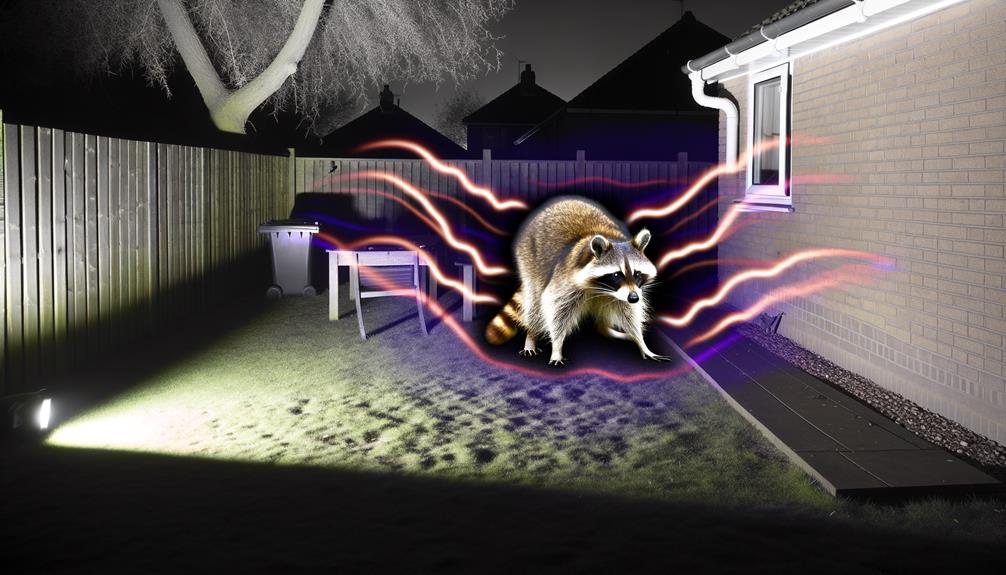How Does Loud Noise Get Rid of Raccoons Effectively?
Loud noises can offer temporary relief in deterring raccoons due to their highly sensitive auditory system, causing immediate discomfort. However, due to their adaptability and intelligence, raccoons may become accustomed to repeated noises over time, reducing the long-term effectiveness of this method.
Practical solutions include devices like air horns and motion-activated alarms, but these need to be combined with other strategies for sustained results. Habitat modifications and humane alternatives such as motion-activated sprinklers and one-way exclusion doors offer more balanced approaches.
For a thorough strategy on managing raccoon presence, further details are essential.

Key Takeaways
- Loud noises can cause immediate discomfort to raccoons, potentially deterring them temporarily.
- Raccoons have acute hearing, making them sensitive to loud and sudden sounds.
- The long-term effectiveness of loud noises is limited due to raccoons' adaptability.
- Individual raccoons may vary in their tolerance to loud noises.
- Practical noise-making tools include ultrasonic devices, air horns, and motion-activated alarms for targeted deterrence.
Understanding Raccoon Behavior
Raccoon behavior is characterized by their nocturnal activity, curiosity, and adaptability to urban environments. These mammals are primarily active at night, engaging in foraging and exploring behaviors that demonstrate high levels of intelligence and resourcefulness.
They exhibit an omnivorous diet, consuming a wide variety of foods, which aids their survival in diverse habitats, including cities. Raccoons are known for their dexterous front paws, allowing them to manipulate objects and access food sources efficiently.
Their adaptability is further evidenced by their ability to exploit anthropogenic resources, such as garbage and pet food. Understanding these behavioral traits is essential for devising effective management strategies, especially in urban areas where human-raccoon interactions are increasingly common.
The Science of Sound
Sound is defined as vibrations that travel through the air or another medium and can be heard when they reach a person's or animal's ear. It plays an important role in the behavior and communication of various species. These vibrations are characterized by their frequency, amplitude, and wavelength, which jointly determine the pitch and volume of the sound.
Animals, including raccoons, use sound for navigation, locating food, and avoiding predators. The auditory system of raccoons is highly developed, allowing them to detect a wide range of frequencies. This sensitivity makes sound an essential environmental factor that can influence their actions and habitat choices.
Understanding the scientific principles of sound is vital for devising effective strategies to manage wildlife interactions.
Effectiveness of Loud Noises
Considering the heightened auditory sensitivity of raccoons, the application of loud noises as a deterrent strategy warrants a detailed examination of its effectiveness.
Studies indicate that raccoons possess acute hearing capabilities, making them particularly susceptible to auditory disturbances. Loud noises can indeed cause immediate discomfort and prompt raccoons to vacate an area temporarily.
However, the long-term efficacy of this method remains inconclusive. Raccoons are known for their adaptability and intelligence, often becoming accustomed to repeated stimuli over time. Additionally, the variability in individual tolerance levels among raccoons complicates the predictability of loud noise as a consistent deterrent.
Hence, while loud noises may offer short-term relief, reliance on this method alone may not guarantee sustained success in raccoon management.
Practical Noise-Making Tools
Frequently employed in wildlife management, practical noise-making tools such as ultrasonic devices, air horns, and motion-activated alarms are utilized to deter raccoons from residential and urban areas.
Ultrasonic devices emit high-frequency sounds that are disturbing to raccoons but inaudible to humans, providing a non-intrusive solution.
Air horns produce a sudden, loud noise that can startle and scare raccoons away, though they may require repeated use.
Motion-activated alarms combine sensors with loud sounds, activating only when raccoons are detected, thereby conserving energy and reducing noise pollution.
These tools offer targeted and immediate deterrence, making them effective in discouraging raccoon presence without causing harm. Their implementation requires consideration of local noise ordinances and potential impacts on human residents.
Alternative Humane Solutions
Alternative humane solutions encompass a variety of non-lethal methods to discourage raccoon activity, ensuring both animal welfare and effective management.
One effective approach involves habitat modification, such as securing trash bins and eliminating food sources, thereby reducing raccoon attraction.
Motion-activated sprinklers can deter raccoons without causing harm, leveraging their natural aversion to sudden water sprays.
Additionally, installing one-way exclusion doors in potential entry points allows raccoons to exit but prevents re-entry, effectively humanely evicting them.
Chemical repellents, like predator urine, can also be strategically placed to create an inhospitable environment.
These methods collectively offer a balanced strategy, promoting coexistence while addressing the concerns of those wishing to serve their communities responsibly.
Conclusion
The use of loud noises to deter raccoons can be effective, yet results vary based on environmental and situational factors. A 2021 study demonstrated that raccoons vacated an area when exposed to high-decibel sounds, but habituation reduced long-term efficacy.
Practical applications, such as motion-activated alarms, provide temporary relief. Alternatives, including exclusion techniques and humane traps, should be considered for sustainable solutions.
Thorough understanding of raccoon behavior and sound dynamics is essential for developing effective deterrent strategies.






